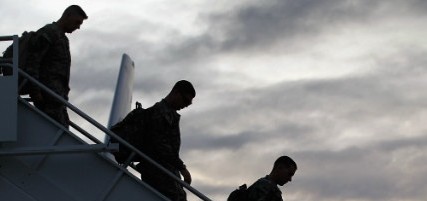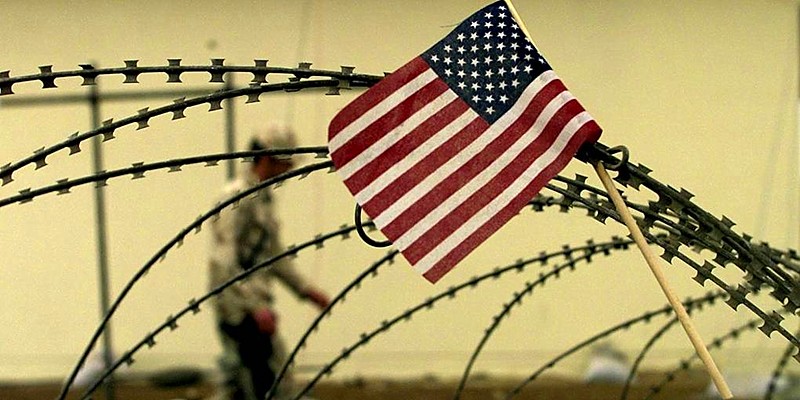What happens when a war ends and an army comes home?
It’s been a vexing problem for centuries.
After completing the long Reconquista of the Iberian Peninsula in the 15th Century, a newly-united Spain turned its attention and its Conquistadors toward the New World.
At the end of the Civil War, the Re-United States shifted its victorious army westward, quickly making the American Indian the Civil War’s biggest loser.
Now the United States faces the problem once again.
The question is whether the Pentagon’s planned reduction of the Army to “pre-World War II levels” will be met with post-World War II solutions, or post-Vietnam-like problems?
The issue now, unlike with those wars, is that America’s army is a “professional” army. Since the post-Vietnam reboot of the Reagan years, military service has become a jobs program, a wide-ranging technical school and training program, and a de facto safety valve for the poor, the working poor and for immigrants seeking a path to citizenship. And for some in the middle class it’s been their only chance of ever affording college.
The “Be All You Can Be” military of the 1980s—along with the “One Weekend a Month” National Guard and Reserves—matched Reagan’s Cold War calculations, but it also met a more subtle desire by a chastened Pentagon to transform the military into a professional army, with economic motivations filling the patriotic void left by the catastrophe of Vietnam.
The Vietnam demobilization was a disaster for many vets who struggled with drug abuse, PTSD, homelessness and, even to this day, a high suicide rate. The inability to absorb scarred and disillusioned draftees during the economically stagnant 1970s was in stark contrast to the overwhelming success of the G.I. Bill and the “go-go” manufacturing economy of the 1950s, which quickly and effectively assimilated a large standing army into comfortable civilian employment.
The assimilation is staggering—active duty forces dropped from the wartime high of 12 million in 1945 to roughly 1.5 million by 1947. A combination of conscription and volunteerism sustained U.S. troop levels thereafter, meeting the increased needs of the Korean War and various Cold War deployments until the burning of draft cards and widespread protests challenged the system.
The Vietnam backlash led to the functional end of the draft and the marketing of military service as a career development program.
As a bonus, this re-branding of service created a new pro-military constituency within the body politic. Like defense contractors’ use of civilian manufacturing jobs to secure congressional support, the new “employee army” offered enlistees a rational economic benefit beyond patriotism. It also gave the economy some help along the way, providing an injection of good old fashioned socialism under the guise of patriotic duty.
While many high school grads accumulated massive, inescapable debts as college students, the all-volunteer military offered a way out of the economic dead-ends created by the unleashing of Wall Street’s financial wizards, the end of manufacturing and the outsourcing of, it seemed, just about everything.
Military service mitigated the effects of Reaganomics in the 1980s, offered an alternative to the free trade and tech-bubble economy of the 1990s and, with a rapid post-9/11 ramp up, created an economic safety net for the faux economy of the new century. Americans were asked to support the troops while employing the troops actually helped to support America’s hollow economy.
Although these Army personnel cuts come at a time when Wall Street enjoys record highs and policymakers talk about “The Recovery” as if it’s an actual thing, Americans remain unconvinced that the rising tide is lifting their boats. Gallup’s latest poll shows unemployment atop their list of concerns, with the “economy in general” a close second. Americans want and need jobs, and not just the type of jobs that will benefit from a rise in the minimum wage.
For those scheduled to leave military service in the near term, they will find themselves in a wage-depressed, job-scarce economy. For those who planned on using the military “safety valve” as a way out of a stagnant future, the Pentagon is curtailing one of the only employment and job-training programs available to the poor, the working poor and the dwindling middle class.
Some called it the “poverty draft”—meaning that the poor had few options other than military service. Military recruiters called it “easy cash,” reaping illicit signing bonuses in what’s become a huge kickback scandal reaching up the chain of command. But none dare call it what it often is—a safety net for those who might otherwise fall through the cracks.
Just think what the Great Recession could’ve been like if America didn’t have over 540,000 people in the Army or a total of 1.4 million in uniform, all earning paychecks, getting healthcare and removed from the harrowing competition of a severely depressed job market?
And what would happen if even a quarter of the 1,387,638 active duty military serving in 2013 tried to get jobs in an economy of $19 billion companies with only 55 employees, bank tellers who depend on public assistance to scrape by and Americans who are one missed paycheck away from disaster?
Maybe the answer is coming, or maybe the answer is that the army isn’t really coming home. Rather, it’s just pursuing some cost-cutting measures designed to lower overhead and increase profitability.
The rise of flying killer robots, warfare by algorithm and a wide array of high-tech options to low-tech boots on the ground all give the Pentagon an easy way to reduce personnel costs without curtailing its global appetite for destruction. On the surface it looks like an incremental step away from empire. But it’s really a corporate-style move to cut the one thing all executives like to cut most—the cost of labor.
In addition to trimming the Army down to around 440,000, other cost-cutting measures include:
- a one-year salary freeze for most officers
- a meager one-percent pay raise for military personnel
- “slowing of growth” in the tax-free housing allowance
- a $1.4 billion subsidy cut to military commissaries
- a rise in health insurance deductibles and co-pays for some retirees and active service family members
Of course, there is nothing here about closing down the Pentagon’s world-wide network of lush golf courses, freezing the F-35 program until rampant cost overruns can be stopped or cutting the actual defense budget. In fact, the White House is plotting a rise in spending for 2016. In light of Secretary Hagel’s plan, these cuts really amount to a windfall for the Military-Industrial makers of high-tech weaponry by shifting cost savings into new, profitable weapons systems.
Meanwhile, active duty enlistees are increasingly reliant upon on food stamps. Last year, military families redeemed $104 million worth of taxpayer-supplied food stamps at those subsidized commissaries the Pentagon wants to trim. That’s up from nearly $25 million in 2007. But it’s still a drop in the bucket compared to the 44 million Americans who rely on those same food stamps, but don’t have access to subsidized commissaries.
So, like civilian workers, military personnel face a daunting future of stagnant wages and declining benefits. If they do come home, the one part of the economy that can absorb them is the growing police state—which receives excess military hardware doled out by the Pentagon, and the flourishing prison system—which leads the world in incarceration. Perhaps out of work soldiers can leverage their training to get jobs guarding the 700,000 veterans currently imprisoned in America.
If so, they’d be closing the “circle of professionalism” that began as a response to Vietnam, but also typified an ongoing unwillingness to invest in the civilian economy like America did at the end of World War II.
Tweet





'Can America Afford To Bring Home The Employee Army?' have 13 comments
February 26, 2014 @ 5:57 pm Keith Oatney
I really enjoyed reading this article. Very well written. Thank you.
February 26, 2014 @ 6:32 pm doug rokke
Given that well over 50% of all individuals who deployed for oif and oef now face serious medical problems with essential medical care being DELAYED OR DENIED. Given too many of the junior enlisted lack adequate academic and / or vocational education required for gainful employment. Given too many lack educational prerequiates for additonal schooling without completing remedial education we face a nightmare. Then we have so many sticking to the myths of combat that they will face the ptsd dogs without any hope of alleviation.
February 27, 2014 @ 7:15 am Anita Patel
The drawdown of military personnel, if no “emergency” intervenes, will be done in a typically capitalist fashion. “You’re out and on your own, soldier.” The hapless individuals so affected will go from being a very well trained individual successfully integrated into an effective fighting force to being a triply damned job seeker.
Firstly, for not having the qualifications civilian employers say they want (qualifications which almost always deny the value of all military training and experience.)
Secondly for having been eliminated from the military. “If you were any good you’d still be in uniform, loser.”
And thirdly being suspected of being unstable, subject to flashbacks and illnesses, and even suspected of criminal behavior or at least a tendency to violence.
February 27, 2014 @ 8:21 am J Nieroski
Meanwhile, benefits for illegal aliens will improve and increase with little effort expended with obtaining those benefits. The undeserving will be rewarded many times over while those who risked everything will be left to twist in the wind.
Anita Patel sums up the situation perfectly with her comment.
February 27, 2014 @ 9:55 am Norma
Yes, you idiot!
They are our precious kids!
There’s no reason factories can’t be rebuilt and jobs filled with Home-originated Inventiveness, the young people can be given jobs for GOOD local CURRENCY farming locally, repairing local roads and bridges.
If they don’t have the skills, the civilians, older fokk that are older and retired, can train the Youth!
All kind of skills can be taught and traded.
February 27, 2014 @ 11:19 am Steve
“There’s no reason factories can’t be rebuilt and jobs filled with Home-originated Inventiveness, the young people can be given jobs for GOOD local CURRENCY farming locally, repairing local roads and bridges.”
In a sane world yes, not here. There ARE
factory jobs with American companies…in
China or Bangladesh.
I see already how the veterans are valued,
I see them begging for change on street
corners every morning.
February 27, 2014 @ 1:06 pm Jorge
I hate to be so negative, but the Outlook is very bleak and will only become more bleak as time passes. America has been transformed from a free economy to a centrally directed economy, which is sort of like passing from being a free person to being a slave. Once you are a slave, the odds of things improving are not good. All decisions that affect you are made by persons or entities that place their interests before yours. To convince them to do otherwise is not easy.
February 27, 2014 @ 2:30 pm Indigo Jones
If there are substantial cuts to the size of the military and the concommittant rise in the unemployment of young men, a recipe for disaster is going to be created. These young men are well trained in the use of guns, are at the prime age for violence and basically are going to be angry at the society that is unable to give them jobs. Perhaps the United States should take over another country, turn it into a colony and repatriate these veterans there. A good candidate for this would be South Africa.
February 27, 2014 @ 5:40 pm Eileen K.
Why South Africa, Indogo? The last thing the US needs to do is take over another country and turn it into a colony and repatriate veterans there; that’s a violation of the Nuremberg Code. The better option for the US would be to put these returning vets – who are stable, of course – at the US-Mexican border which, btw, is over 2,000 miles long from CA to TX, to keep illegal aliens and drug cartel gangs out.
February 27, 2014 @ 7:21 pm crusty clowne
By the looks of how things are going regarding the NSA, the internment camps across America, the billions of rounds of bullets and hundreds of thousands of sniper shells being bought by Homeland Security, etc., isn’t it obvious where the next war may happen when all these combat scarred soldiers return home?
March 1, 2014 @ 12:43 pm Janice E. Erganoff Stalker
Oh MY!! Someone who actually GOT / GETs it!!
May I also insert (suggest) 3/4 other insights (dots?) to YOUR Fantastic analysis?
1. Remember the remark by ‘ol Colin Powell… “We handle Everyone Differently!” Somewhat pertinent to the point of how to aju$T Au$TeRiTY measures to THI$ country under the radar.
2. Suicide numbers are astounding now… wait!!
3. With the “Job Training” that has been obtained by most Military Members… You may be a SHOE IN for employment with the USA militia of “Ollie and Prince” international iNC!! Where the benefits are 1 of 2… Mega buck$ or DEATH!
4… Now all that’s left are tho$e darn Baby BoOMeR$!! duh!
Again… THANK YOU!! One of the ONLY I’ve seen that saw the REAL “PLaN!” (That’s why Hagel “pretty boy” was put in there…)$ell and Cover!
PSst… YeS! DOD and N$A Love the “Legitimate” Name!!! Buds for years!
April 21, 2014 @ 1:17 pm marc labelle
Caught a glimpse of you on max keiser and decided to see what you’re about. Wow! Best online writing ever. Nobody ever writes about
the actual war machine structure..you’ve got a friend.
April 28, 2014 @ 3:57 am TommiStough's Blog | Newz #001
[…] worst-Writer prefers not to call voluntary service but instead economic conscription but there are o…. […]